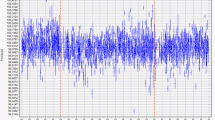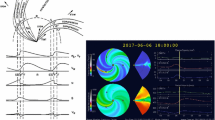Summary
Directional measurements of the hard component of the cosmic rays, employing narrow-angle telescopes, were made at the four principal azimuths at Gulmarg (2700 m;λ=24.7° N). The results were compared with the earlier measurements ofGill andMitra at the same laboratory. Absolute directional intensities and flux were calculated and listed. The present vertical intensity was found to be at least (13÷15)% lower than that recorded in 1954 at the same place. The fine-structure analysis of the data indicated that the present results do not rule out the existence of anomalies in the zenithal distributions of the cosmic-ray intensity. Zenithal distributions were also compared withQuercia andRispoli’s meson differential spectra which indicated that theoretical intensities were in fair agreement with the observed intensities. The study of fractional energies, transmitted by incident protons to mesons, east-west, north-south asymmetries and south-west differences provided a possible evidence to show that geomagnetic cut-off energies as given byLemaitre andVallarta theory need to be revised in the N-S plane at large angles at intermediate latitudes. The data also indicated considerable variation of the east-west asymmetry with solar activity.
Riassunto
Si sono eseguite nei quattro azimut principali a Gulmarg (2700 m,λ=24.7 °N) misure direzionali della componente dura dei raggi cosmici, con telescopi ad angolo ristretto. Si sono confrontati i risultati con precedenti misure di Gill e Mitra nello stesso laboratorio. Si sono calcolate ed elencate le intensità direzionali assolute ed i flussi. Si è trovato che l’attuale intensità verticale è almeno del (13÷15)% inferiore a quella registrata nel 1954 nello stesso posto. L’analisi della struttura fine dei dati indica che gli attuali risultati non escludono l’esistenza di anomalie nella distribuzione zenitale dell’intensità dei raggi cosmici. Si sono anche confrontate le distribuzioni zenitali con gli spettri differenziali mesonici diQuercia eRispoli, rilevando che le intensità teoretiche sono in buon accordo con quelle osservate. Lo studio delle energie frazionali, trasmesse ai mesoni dai protoni incidenti, le asimmetrie est-ovest, nord-sud e le differenze sud-ovest hanno fornito una possibile prova per dimostrare che le energie del taglio geomagnetico date dalla teoria di Lemaitre e Vallarta devono essere revisionate nel piano N-S ai grandi angoli a latitudini intermedie. I dati indicano anche una considerevole variazione dell’asimmetria est-ovest con l’attività solare.
Similar content being viewed by others
References
P. S. Gill andA. N. Mitra:Nuovo Cimento,9, 400 (1958).
E. J. Schremp andA. Banos:Phys. Rev.,58, 662 (1940);59, 614 (1941).
H. S. Ribner:Phys. Rev.,56, 1069 (1939).
D. Cooper:Phys. Rev.,58, 288 (1940).
G. Cocconi andV. Tongiorgi:Phys. Rev.,70, 850 (1946).
I. F. Quercia, B. Rispoli andS. Sciuti:Nuovo Cimento,7, 715 (1950);I. F. Quercia andB. Rispoli:Nuovo Cimento,12, 490 (1954).
M. K. Khera:Ph. D. Thesis, Aligarh Muslim University, Aligarh.
K. Greisen:Phys. Rev.,61, 212 (1942).
B. Rossi:Rev. Mod. Phys.,20, 537 (1948).
H. V. Neher:Prog. in Cosmic Ray Physics, vol.1, 245 (1951).
P. S. Gill andM. K. Khera:Bull. Nat. Sci. India,9, 39 (1957).
P. Rothwell:Phil. Mag.,3, 961 (1958).
E. J. Schremp (1934–35). SeeE. J. Schremp andH. S. Ribner:Rev. Mod. Phys.,11, 149 (1939).
P. S. Gill:Ind. Journ. Phys.,28, 335 (1954).
M. L. Yeater:Phys. Rev.,67, 74 (1954).
I. F. Quercia andB. Rispoli:Nuovo Cimento,10, 1142 (1953).
P. Caldirola:Nuovo Cimento,6, 565 (1949).
P. Caldirola andA. Loinger:Nuovo Cimento,7, 161 (1950).
R. P. Kane:Journ. Geophys. Res.,67, 1295 (1962).
G. Lemaitre andM. S. Vallarta:Phys. Rev.,49, 719 (1936);50, 493 (1936).
P. S. Gill:Phys. Rev.,60, 153 (1941).
M. Schwartz:Suppl. Nuovo Cimento,11, 27 (1959).
J. E. Kasper:Suppl. Nuovo Cimento,11, 1 (1959).
T. H. Johnson:Phys. Rev.,48, 287 (1935).
Author information
Authors and Affiliations
Rights and permissions
About this article
Cite this article
Gill, P.S., Khera, M.K. Directional distribution of the hard component of cosmic rays. Nuovo Cim 32, 33–47 (1964). https://doi.org/10.1007/BF02732589
Received:
Published:
Issue Date:
DOI: https://doi.org/10.1007/BF02732589




